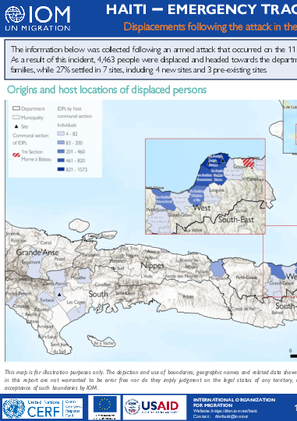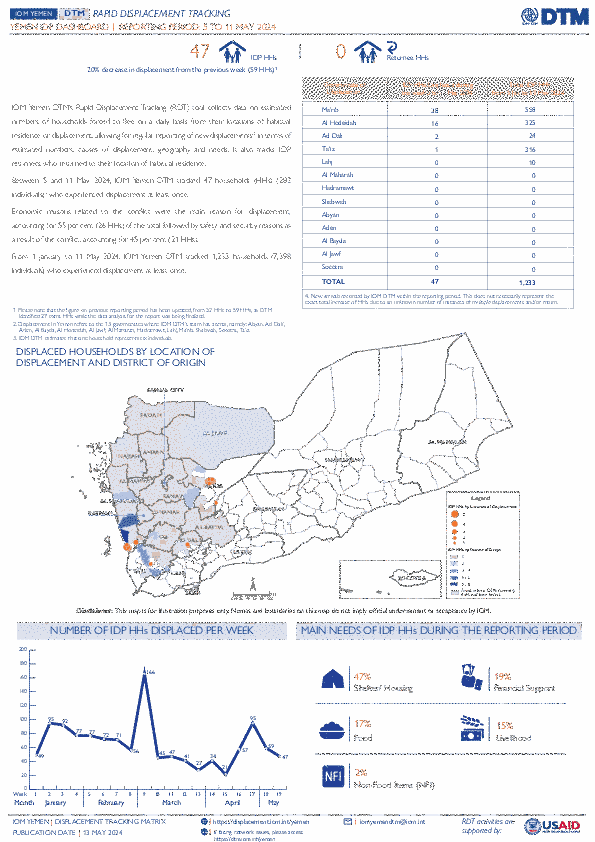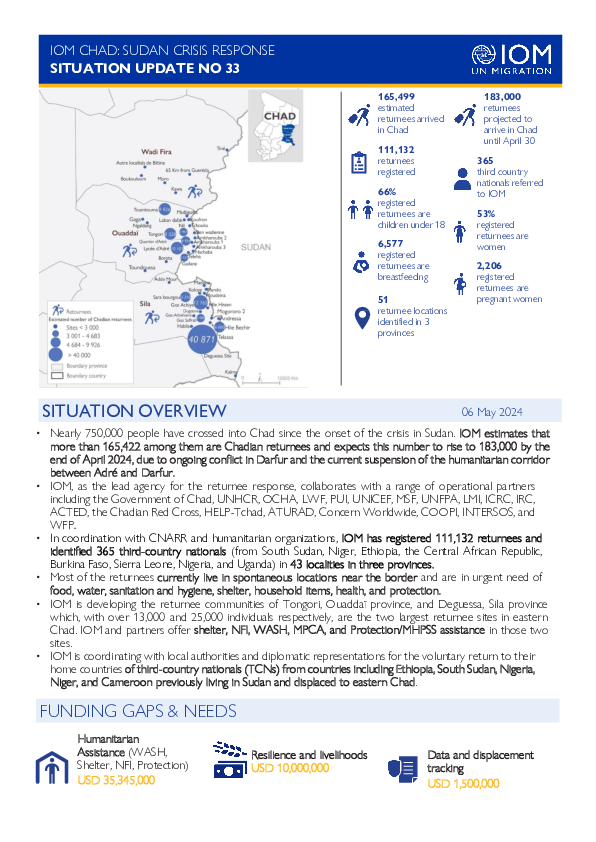-
Countries
-
Data and Analysis
-
Special Focus
-
Crisis Responses
Event Tracking

Contact
dtmhaiti@iom.int
Language
English
Location
Haiti
Period Covered
May 11 2024
May 12 2024
Activity
- Mobility Tracking
- Event Tracking
The information below was collected following an armed attack that occurred on the 11 of May 2024 in the municipality of Gressier, specifically in the 1st section of Morne à Bateau. As a result of this incident, 4,463 people were displaced and headed towards the departments of Ouest (92%), Nippes (4%), and Sud (3%). Among them, 73% found refuge with host families, while 27% settled in 7 sites, including 4 new sites and 3 pre-existing sites.

Contact
DTM DRC — iomdrcdtm@iom.int
Language
French
Location
Democratic Republic of the Congo
Period Covered
Apr 25 2024
May 06 2024
Activity
- Mobility Tracking
- Event Tracking
L’évaluation rapide de l’OIM (Emergency Event Tracking, EET) est un outil mis en place dans le but de collecter des informations sur les mouvements importants et soudains des populations. Ces informations sont collectées à la suite de visites terrain et/ou d’entr etiens téléphoniques avec les informateurs clés des sites de déplacement ou des communautés d’accueil. Les informations sont ensuite recueillies dans les outils ERM. Ce rapport synthétique présente les résultats des évaluations réalisées du 25 avril – 6 mai 2024 à travers des évaluations menées sur terrain avec les informateurs clés. La province du Tanganyika est confrontée à un nombre de situations interconnectées qui sont liées à la mobilité humaine. Le changement climatique, dont les effets sont déjà visibles dans la région, a entraîné une montée des eaux des rivières et du lac Tanganyika, ainsi qu'une augmentation des phénomènes météorologiques extrêmes tels que les canicules et les inondations. Les inondations et les pluies torrentielles, phénomènes récurrents au Tanganyika depuis février 2024, ont particulièrement affecté les établissements côtiers du lac Tanganyika. Les inondations, l'érosion et les glissements de terrain ont causé la destruction d'habitations et d'infrastructures et ont entraîné le déplacement des populations locales, en particulier à : Rugo, Kamenge, Kimomo, Kabubili et toute la rive du lac le long de l'axe Kabimba dans le groupement Kasanga Mtoa, Tumbwe Chefferie. Des dommages/destructions de plus d'un millier d'habitations ainsi que des terres agricoles, des récoltes, d'autres biens mobiliers et des écoles ont été signalés. Plus de 1 800 ménages ont trouvé refuge auprès de familles d'accueil dans des villages et localités plus sûrs, ainsi que dans le site de déplacement de Rugo (sous la coordination de l'OIM).
Contact
DTM Yemen, iomyemendtm@iom.int
Location
Yemen
Activity
- Mobility Tracking
- Event Tracking
Period Covered
May 05 2024 -May 11 2024
From 1 January to 11 May 2024, IOM Yemen DTM tracked 1,233 households (HH) (7,398 Individuals) who experienced displacement at least once.
Between 5 and 11 May 2024, IOM Yemen DTM tracked 47 households (282 individuals) displaced at least once. The majority of people moved into/within the following governorates and districts:
- Ma’rib (28 HHs) – Ma’rib City (14 HHs), Ma’rib (13 HHs), Harib (1 HH) districts. Most displacements in the governorate originated from Ta’iz and Al Hodeidah.
- Al Hodeidah (16 HHs) – Al Khukhah (13 HHs), Hays (3 HHs) districts. Most displacements in the governorate were internal.
- Ad Dali (2 HHs) – Qatabah (2 HHs) district. All displacements in the governorate were internal.
The majority of people moved from the following governorates and districts:
- Al Hodeidah (18 HH) – At Tuhayta (8 HHs), Bayt Al Faqih (6 HHs), Bajil (2 HHs) districts.
- Ta’iz (13 HH) – Maqbanah (4 HHs), Ash Shamayatayn (3 HHs), Hayfan (3 HHs) districts.
- Hajjah (4 HH) – Hajjah City (2 HHs), Harad (1 HH), Al Jamimah (1 HH) districts.
Population Groups
IDPs
Returnee (Previously Internally Displaced)
Survey Methodology
Unit of Analysis Or Observation
Admin Area 2
Type of Survey or Assessment
Household
Keywords
Geographical Scope Partial Coverage
Administrative boundaries with available data
The current dataset covers the following administrative boundaries

Contact
DTM Yemen, iomyemendtm@iom.int
Language
English
Location
Yemen
Period Covered
May 05 2024
May 11 2024
Activity
- Mobility Tracking
- Event Tracking
IOM Yemen DTM’s Rapid Displacement Tracking (RDT) tool collects data on estimated numbers of households forced to flee on a daily basis from their locations of origin or displacement, allowing for regular reporting of new displacements in terms of estimated numbers, geography, and needs. It also tracks returnees who returned to their location of origin.
From 1 January to 11 May 2024, IOM Yemen DTM tracked 1,233 households (HH) (7,398 Individuals) who experienced displacement at least once.
Between 5 and 11 May 2024, IOM Yemen DTM tracked 47 households (282 individuals) displaced at least once. The majority of people moved into/within the following governorates and districts:
- Ma’rib (28 HHs) – Ma’rib City (14 HHs), Ma’rib (13 HHs), Harib (1 HH) districts. Most displacements in the governorate originated from Ta’iz and Al Hodeidah.
- Al Hodeidah (16 HHs) – Al Khukhah (13 HHs), Hays (3 HHs) districts. Most displacements in the governorate were internal.
- Ad Dali (2 HHs) – Qatabah (2 HHs) district. All displacements in the governorate were internal.
The majority of people moved from the following governorates and districts:
- Al Hodeidah (18 HH) – At Tuhayta (8 HHs), Bayt Al Faqih (6 HHs), Bajil (2 HHs) districts.
- Ta’iz (13 HH) – Maqbanah (4 HHs), Ash Shamayatayn (3 HHs), Hayfan (3 HHs) districts.
- Hajjah (4 HH) – Hajjah City (2 HHs), Harad (1 HH), Al Jamimah (1 HH) districts.
IOM identified 27 additional households displaced in the previous reporting period, which covered 28 April - 04 May 2024, in the governorates of Al Hodeidah (15 HHs), Ma’rib (11 HH), and Ta’iz (1 HH). These figures have been added to the cumulative displacement total recorded since the beginning of the year.

Contact
DTM Nigeria, iomnigeriadtm@iom.int
Language
English
Location
Nigeria
Period Covered
Apr 29 2024
May 05 2024
Activity
- Mobility Tracking
- Event Tracking
Between 29 April and 5 May 2024, a total of 1,005 new arrivals were recorded at locations in Adamawa and Borno states. The new arrivals were recorded at locations in Askira/Uba, Bama, Gubio, Gwoza, Kaga, Kala Balge, Mafa, Monguno and Ngala Local Government Areas (LGAs) of the most conflict-affected Borno State and in Fufore, Gombi, Hong, Lamurde, Madagali, Maiha, Michika, Mubi North, Song, Toungo, Yola North and Yola South LGAs of Adamawa State. ETT assessments identified the following movement triggers: poor living conditions (370 individuals or 37%), seasonal farming (148 individuals or 15%), improved security (144 individuals or 14%), military operations (118 individuals or 12%), family re-unification (90 individuals or 9%), fear of attack (87 individuals or 8%), attack (29 individuals or 3%) and access to humanitarian support (19 individuals or 2%)

Contact
DTM Burundi, DTMBurundi@iom.int
Language
English
Location
Burundi
Period Covered
Apr 16 2024
Apr 21 2024
Activity
- Mobility Tracking
- Event Tracking
Le rapport DTM indique qu'entre le 16 et le 21 avril 2024, au Burundi, 19 573 personnes ont été affectées et 4 783 déplacées suite à des pluies torrentielles, des glissements de terrain, et des inondations nécessitant une réponse immédiate de la communauté humanitaire. Parmi les affectés, 10 755 sont des femmes et 8 818 sont des hommes.

Contact
DTM Burundi, DTMBurundi@iom.int
Language
English
Location
Burundi
Period Covered
Apr 28 2024
May 04 2024
Activity
- Mobility Tracking
- Event Tracking
La DTM Burundi a le plaisir de vous partager (dans le lien ci-dessus) des informations sur les urgences qui se sont produites au Burundi en dates du 29 avril au 04 mai 2024. La DTM a identifié 16 353 personnes affectées (3 170 ménages) dont 2 162 personnes déplacées (405 ménages) par les pluies torrentielles, les inondations et les glissements de terrain dans les provinces de Bujumbura Rural, Cibitoke, Kirundo, Muyinga, Ngozi et Rumonge.

Contact
dtmhaiti@iom.int
Language
English
Location
Haiti
Period Covered
Apr 25 2024
May 07 2024
Activity
- Mobility Tracking
- Event Tracking
The information below was collected following several armed attacks that occurred between 25 April and 5 May 2024, in the commune of Delmas, specifically in the neighborhoods of Cité Numéro 2 (Delmas 24) and Solino. As a result of these incidents, residents from six sites located in the neighborhoods of Cité Numéro 2, Carrefour Pean, 2ème cité Saint Martin, and Sylvio Cator - Delmas 28 were forced to evacuate these sites. In total, 5,178 individuals were displaced, including residents from these six sites and residents from the Cité Numéro 2 neighborhood. Internally displaced persons (IDPs) headed towards the communes of Port-au-Prince, Delmas, Croix-Des-Bouquets, and Tabarre. Among them, 51% found refuge with host families, while 49% settled in ten sites, including six new sites and four pre-existing sites.

Contact
DTM Chad, dtmtchad@iom.int
Language
English
Location
Chad
Snapshot Date
May 06 2024
Activity
- Mobility Tracking
- Event Tracking
• Nearly 750,000 people have crossed into Chad since the onset of the crisis in Sudan. IOM estimates that more than 165,422 among them are Chadian returnees and expects this number to rise to 183,000 by the end of April 2024, due to ongoing conflict in Darfur and the current suspension of the humanitarian corridor between Adré and Darfur.
• IOM, as the lead agency for the returnee response, collaborates with a range of operational partners including the Government of Chad, UNHCR, OCHA, LWF, PUI, UNICEF, MSF, UNFPA, LMI, ICRC, IRC, ACTED, the Chadian Red Cross, HELP-Tchad, ATURAD, Concern Worldwide, COOPI, INTERSOS, and WFP.
• In coordination with CNARR and humanitarian organizations, IOM has registered 111,132 returnees and identified 365 third-country nationals (from South Sudan, Niger, Ethiopia, the Central African Republic, Burkina Faso, Sierra Leone, Nigeria, and Uganda) in 43 localities in three provinces.
• Most of the returnees currently live in spontaneous locations near the border and are in urgent need of food, water, sanitation and hygiene, shelter, household items, health, and protection.
• IOM is developing the returnee communities of Tongori, Ouaddaï province, and Deguessa, Sila province which, with over 13,000 and 25,000 individuals respectively, are the two largest returnee sites in eastern Chad. IOM and partners offer shelter, NFI, WASH, MPCA, and Protection/MHPSS assistance in those two sites.
• IOM is coordinating with local authorities and diplomatic representations for the voluntary return to their home countries of third-country nationals (TCNs) from countries including Ethiopia, South Sudan, Nigeria, Niger, and Cameroon previously living in Sudan and displaced to eastern Chad.

Contact
dtmmozambique@iom.int
Language
English
Location
Mozambique
Period Covered
Apr 17 2024
May 05 2024
Activity
- Mobility Tracking
- Event Tracking
Between 17 April and 5 May 2024, sporadic attacks, and fear of attacks by Non-state Armed Groups in Ancuabe, Chiúre and Erati triggered the cumulative displacement of 54,415 individuals/13,131 families. The current Movement Alert #110 reports on most recent attacks in southern Cabo Delgado. For more information on displacements between February and March, please see {Emergency Tracking Online Dashboard}.
Ancuabe attack | 2,959 Individuals displaced (17 April - 5 May 2024): Within the reporting period, attacks, and the fear of attacks by Non-State Armed Groups in Ancuabe led to the displacement of 2,959 individuals.
Chiure attack | 51,012 Individuals displaced (17 April – 5 May 2024): Within the reporting period, attacks, and fear of attacks by Non-State Armed Groups in Chiúre led to the displacement of 51,012 individuals.
Erati attack | 49,031 Individuals displaced (17 April – 5 May 2024): Within the reporting period, attacks, and fear of attacks by Non-State Armed Groups in Erati led to the displacement of 444 individuals.
Pagination
- Previous page
- Page 31
- Next page
